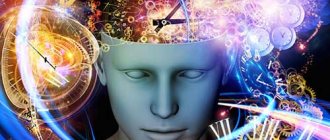The most curious question of where a person’s dreams come from comes to mind even in childhood. Almost every person regularly sees dreams, these are some fleeting images or entire plots, like in a movie. Most often we see dreams from the first person, less often from the third. In the morning, the dream or most of it is forgotten, but sometimes we remember them, because during the day we remember those realistic experiences and vivid images.
Scientists are also interested in the mechanism of dreams. A lot of research has been done on this topic and many papers have been written. But science cannot accurately answer the question of what causes dreams. There are several theories that are considered the most plausible, they are presented in this article. We will also look at other important topics: who and when tends to have vivid dreams, why do people suffer from nightmares, what other dreams are there?
To understand dreams, you need to understand what sleep is and why people need it so much. This is a natural state that is divided into several cycles. The brain continues to work, but its activity decreases, and the reaction to external stimuli is dulled. For a long time, everything related to sleep remained a mystery. Now science has learned a lot, but not everything we would like.
Many are of the opinion that we need sleep to relax. But this was refuted in the last century. Studies have shown that during sleep, brain activity decreases by only 10-15% relative to light sleep. As for the muscular system, to rest it you just need to be at rest.
Therefore, at the moment, sleep is no longer considered as rest, but as a mechanism of self-regulation. This is a relief for the psyche, an opportunity to systematize memories for the brain, a reduction in stress for the body as a whole, a period of active removal of toxins and renewal of body cells.
If you don't get enough sleep regularly, the body's defenses are weakened, problems with metabolic processes are created, and the risk of cardiovascular diseases increases. And if we don’t sleep for two days or longer, then we will encounter clouding of consciousness and even hallucinations, auditory and visual, an exacerbation of paranoid traits, and a lack of coherent thinking and speech. Without sleep, the body wears out greatly; if a person does not sleep for ten days, he will lose his mind or die.
About sleep cycles
On average, there are 4-5 sleep cycles per night, each of which has certain stages with varying degrees of brain activity.
NREM sleep includes the following stages:
- superficial sleep, preparation for the transition to deep sleep. Consciousness is unfocused, uncontrollable images emerge;
- light sleep. Temperature and pulse become lower than daily values, metabolism slows down, muscles are relaxed, but this is not yet deep sleep. If you call a person by name, he will easily wake up;
- slow sleep, preparation for deep sleep, brain activity slows down;
- deep slow sleep. It is difficult to wake a person because he is fast asleep. It is at this stage that people can talk or walk. Dreams are experienced, but usually not remembered. It is during this period that cell renewal and energy accumulation for the next day occurs.
If the day is spent physically active, the deep stage will last longer.
This is not the entire sleep mechanism. Then there is a return to the second stage, then REM sleep comes. Brain activity increases sharply, it approaches the state of wakefulness. All muscles are relaxed, only the eyes move under closed eyelids, the pulse accelerates, the temperature rises. At this stage, we have vivid dreams that we remember. In each subsequent cycle, the REM sleep phase will be longer, which is why they say that the most vivid dreams occur in the morning.
Physiology and psychology of dreams
The article analyzes the most famous physiological and psychological concepts and models of dreaming. All models and concepts are considered from the point of view of the function that they assign either to the sleep phase with dreams (physiological models) or to dreams themselves (psychological models). The main functions of dreams are considered to be compensatory and restorative, informational and maintaining the state of sleep.
The following functions of dreams are most often considered: a method of compensation and restoration of mental and somatic homeostasis, a method of processing information received during the day, a means of protecting the sleep state from the invasion of mental and somatic stimuli.
From a physiological point of view, dreams are more characteristic of the so-called rapid (paradoxical) sleep phase, or, in other words, the rapid eye movement phase of sleep. This phase of sleep is called paradoxical due to the fact that during this period the vegetative parameters of a person’s state reach, unlike other periods of sleep, the level of wakefulness. At the same time, this state differs significantly from wakefulness in that of all the activating systems of the brain, only a few are involved in paradoxical sleep, and very important monoaminergic neurons of the brain stem are not active. Paradoxical sleep is triggered from the center of the cortex, located in the back of the brain in the area of the pons and medulla oblongata. Usually, when talking about dreams, they mean the hallucinatory production of the cortex precisely in this phase of sleep, but it is not excluded that dreams also occur during other periods of sleep.
Almost all psychological models of dreams were formed as a result of the needs of psychotherapeutically oriented psychological schools. Accordingly, dreams in them are considered, for example, as:
- an attempt to return to consciousness repressed, unacceptable personal experience (psychoanalysis);
- compensatory efforts to return conscious aspirations to fundamental unconscious attitudes (analytical psychology);
- preparing the subject for future waking difficulties (individual psychology);
- existential messages about the current internal situation to the subject’s consciousness with an attempt to complete the problematic situation, objectified by the dream figure (Gestalt psychology);
- restoration of the ability for search activity through the replacement of a real situation that frustrates such activity with an artificial one, symbolically connected with the real one (Rotenberg model).
The above psychological models and concepts, of course, do not exhaust the variety of psychological approaches to understanding dreams.
Physiological approaches to understanding the phenomenon of dreams
Compensatory-restorative aspect of dreams
The abundance of physiological models makes it possible to review them only in the most generalized form. Thus, in the domestic school of physiology, for a long time the approach based on the idea of I.P. prevailed. Pavlov that dreams are the result of chaotic disinhibition of various parts of the cortex. Developing the teachings of I.P. Pavlova, F.P. Mayorov [1] proposed a theory according to which dreams, which are a function of the cerebral cortex and subcortex, are considered as an organic part of the sleep process. At the same time, they represent a disinhibition of neural traces associated with the past life experience of a person who dreams under the influence of external stimuli and internal changes in the brain. The sequence of dream pictures is based on temporary cortical connections and associations.
The phenomenon of dreams was fundamentally studied by V.N. Kasatkin, who considered dreams as a conditioned reflex process. For V.N. Kasatkina, it was important that dreams can occur in any, and not just in the paradoxical phase of sleep, and the nature of dreams in different phases differs significantly [2, 3]. Thus, in the slow-wave sleep phase, visual images of the past day in gray-yellow colors predominate.
Other authors note that such dreams resemble rumination rather than hallucinatory experiences. In the paradoxical phase of dreams, they are more colorful and operate with deeper memories. The representation of various channels of perception during wakefulness corresponds to the same proportion in dreams. The incomprehensibility of the dream, according to V.N. Kasatkina, is explained by pre-threshold, random, not important on a conscious level, traces fixed in memory, as well as pre-threshold sensations of a somatic nature, which are expressed in visual scenes. Dreams can reflect normal and pathological processes in the body. A connection was noted between the frequency, richness of the content of dreams and mental activity, level of intellectual development, profession and emotional sphere of the subject.
The research of modern physiologists and biologists is much deeper and more detailed and is sometimes accompanied by unexpected results. In particular, N. Lortkipanidze and M. Maisuradze (2008) came to a very non-trivial conclusion that the phase of paradoxical sleep can be fully replaced by wakefulness [4].
In the work of A. Stevens, it was shown that brain waves during paradoxical sleep originate in the brainstem and spread upward, through the diencephalon, into the cortex (“young brain”) [5]. Proof that the structures of the “ancient” brain play a significant role in the dreams of a modern person are such dream plots as falling from a height, escaping from a pursuer, repelling an attack and constantly repeating attempts to solve the same problem, etc.
Animal studies of M. Jouvet are noteworthy [6]. Using the electrocoagulation method, the locus coeruleus was destroyed in cats, as a result of which the muscles did not relax during sleep, and the cats moved in accordance with the plot of the dream. They rose on their hind legs and fought with their front legs against their dreaming enemies. Animals ran around the laboratory, hunting imaginary mice or fleeing from imaginary enemies. Some cats moved their jaws and licked their lips as if eating. Others “lapped” milk from imaginary bowls. During all these actions, the cats' eyes could be either open or closed, and being in a state of sleep was confirmed by an electroencephalogram taken. During the experiment, an increase in the aggressiveness of animals during sleep was noted. It was difficult to awaken the animals even with the help of strong stimuli. Similar results were obtained in 1982 by A. Morrison [7]. Summarizing the available observations, M. Jouvet suggested that during the course of evolution in higher animals, the mechanism of dreams arose as a way of training and consolidating forms of natural, instinctive behavior.
Of particular interest is the evolutionary approach to understanding the phylogenesis of sleep and its paradoxical phase, which was proposed by one of the founders of the modern school of “lucid dreaming” S. LaBerge [8]. It includes the following items:
1. Slow-wave sleep arose in warm-blooded animals as a way to save energy during the passive phase (night or day) approximately 180 million years ago as a result of the separation of warm-blooded animals from cold-blooded animals.
2. REM sleep appeared along with the development of viviparity, approximately 130 million years ago. Warm-blooded newborns, unlike cold-blooded ones, are helpless and take time to develop. The REM sleep phase in newborns is several times longer than in adults. REM sleep functions to stimulate the development of the nervous system and psyche of newborns.
3. The evolution of forms of behavior from reflexive to instinctive, then to habitual and, finally, to intentional suggests that intentional behavior is activated in a complex and unpredictable environment. Adult dreams allow for separation from the outside world and the exploration of alternative patterns of behavior, experience, and understanding, allowing animals capable of REM sleep to better adapt to their environment.
Thus, most physiological models consider the phase of paradoxical sleep and dreaming as an integral part of the recreational process.
Information aspect of the dream
According to the activation model of JA Hobson and R. McCarley [9, 10], dreams arise as a result of the fact that during sleep, signals from the lower parts of the brain reach the higher ones. The higher parts of the brain, by combining and comparing with existing experience, try to connect them into a single narrative. Dreams are a direct reflection of the process when in memory there is a search and viewing of images that most correspond to endogenously generated patterns of excitation.
Arguing with the authors of the activation model, A. Rothenberg rightly notes that this approach does not explain the emergence of symbolism in dreams [11]. JA Hobson argues that dream metaphors are high-level associations that synthesize a large amount of information [12].
Many researchers specifically emphasize the importance of emotions in dreams. Thus, S. Lowy believes that dreams both generate and regulate emotions. The sleep process affects metabolism, so it regulates feelings, but at the same time it creates images that these feelings evoke. Dreams are not originally intended to be consciously remembered; their purpose is to be “consciously” experienced during sleep [13]. And I. Wasserman and B. Balif believe that if a person wakes up with a certain feeling, then it corresponds to the emotional coloring of the final part of the dream [14].
E. Hartmann [15] develops the approach of JA Hobson, including in consideration the processes occurring in the slow-wave sleep phase. In slow sleep, logical processing of information from short-term memory occurs (“slow dreams” are more like reflections than imaginative experiences), and in fast sleep, the results of processing are linked with existing material in long-term memory, which is what is represented in the plot of the dream. At the same time, the functionality of the paradoxical sleep phase is due to the fact that it:
- cleanses the nervous system of metabolites accumulated in other phases of the sleep-wake cycle;
- provides the developing brain of a child or even a fetus with an internal source of quasi-sensory stimulation of the cortex;
- reorganizes discharge patterns in the central nervous system that are disrupted during the slow-wave sleep phase;
- is a necessary recovery period preparing the gradual transition to wakefulness from the period of sensory deprivation during the slow-wave sleep phase;
- in the paradoxical phase, accumulated unnecessary information is “dumped”, which opens up the possibility of perceiving something new;
- in the phase of paradoxical sleep, the contents of short-term memory are transformed into long-term memory. At the same time, according to this point of view, part of the information is “reset”, that is, subjected to absolute forgetting;
- in paradoxical sleep, mental activity is aimed at solving current emotional problems of sleep and ensures the body’s adaptation to the environmental conditions at this time.
According to the concept of dreaming as a process of “anti-learning” by F. Crick and G. Mitchison, close to the model of E. Hartmann, the function of dreams is to remove certain unwanted connections between nerve cells in the cerebral cortex. Sleep is a period of disposal of unnecessary information and a way to forget it. Therefore, if for some reason a dream is remembered, it should be forgotten as quickly as possible, since the patterns of dream behavior are destructive for a waking person [16].
Dreaming as a way to maintain the sleep state
The approach of JA Hobson and R. McCarley and the approach of D. Foulkes [17], which is close to it (a dream is a cognitive scheme that organizes the chaotic activation of memory), in addition to the informational aspect, can be considered from these positions. In particular, the cognitive schemas that the higher parts of the brain use to try to “shape” the activity coming from the lower parts are often viewed as “fairy tales that the brain tells itself at night” with an apparently protective meaning to the state of sleep itself.
The approach of G. Globus [18] is also based on the idea of “cognitive design” of spontaneous impulses coming from the lower parts of the brain, however, they activate not random memory elements, but those that are significant in the subject’s current situation. G. Globus agrees with AJ Hobson and R. McCarley that dreams are neurologically determined. Erratic bursts of neural activity stimulate the secretion of biochemical neurotransmitters in the brain and thus trigger the dream activation mechanism. At the same time, unconscious fears and desires are also activated by this random stimulation and are realized as soon as the block of corresponding memories is active. Thus, for G. Globus, the nature of dreams is not chaotic, but, on the contrary, filled with meaning.
Psychological approaches to understanding the phenomenon of dreams
Dreaming as a way to preserve sleep in psychoanalytic theory
S. Freud's model of dream formation was formed by him at a time when the processes of inhibition were not yet known, and in this sense, his concept of “repression” as a way of keeping active mental contents under control looked quite convincing. S. Freud's idea [19] regarding dreams was that they are caused by active but repressed thoughts, desires and fantasies hidden from the dreamer himself. Repression is provoked by the incompatibility of such desires with a person’s conscious attitude.
In psychoanalysis, repression is understood as a special type of forgetting, which is caused by the incompatibility of certain mental contents with a person’s conscious ideas about himself or with a traumatic nature. The basis of such contents is various kinds of infantile sexual or aggressive impulses. Daytime events in one way or another activate these unconscious contents, and during sleep (fig.), when the line of repression weakens, they reach the border of perception. In the sleep state, the motor response of desires is blocked and the excitation caused by these desires is directed towards the areas of the cortex responsible for perception, mainly visual and auditory. Having reached them, arousal causes the hallucinatory fulfillment of these repressed desires, but in a distorted form acceptable for censorship.
As can be seen from the figure, during sleep, the repressed attraction, relying on random stimuli and superimposed on neutral, that is, not receiving any emotional evaluation, remnants of daytime impressions, encounters the work of the mechanisms of condensation, displacement and symbolization (the purpose of which is to mask the original forbidden desires) find their expression in the form of dreams. This process is called dream work. The neutrality of the remnants of daytime impressions is important because, having received any emotional assessment, they can no longer be used as free “building material” for a dream due to their connection with certain affects.
Thus, the main function of a dream is to preserve the state of sleep itself, which is endangered due to the influence of strong and insufficiently repressed mental and somatic stimuli. Psychoanalytic ideas about the functionality of dreams are not exhausted by this; S. Freud’s model of dream formation includes the fulfillment of repressed desires, the healing of narcissistic injuries, the contact barrier between the conscious and unconscious psyche, and a number of other aspects.
Compensatory functionality of dreams in the concept of CG Jung
Unlike psychoanalysis, where dreams are viewed as in some sense a “by-product” that arises as a reaction to the repression of intolerable material, in analytical psychology dreams are given a much more significant role. This is due to the ideas of the analytical school that dreams play the role of a natural regulator of the relationship between the unconscious and conscious parts of the psyche and represent messages from one of the aspects of the unconscious to consciousness (more precisely, to the Ego complex). Such a message should compensate for the accumulated discrepancy between a person’s conscious attitude and his unconscious aspirations. According to CG Jung, dreams:
- express unconscious processes at the personal and archetypal level;
- contain meaning that can be understood;
- reflect the compensatory relationship between the unconscious and consciousness;
- indicate the direction of a person’s mental individuation.
In compensatory terms, three types of relationships between the unconscious and consciousness and, accordingly, three types of dreams can be distinguished.
The first type of relationship includes a complete discrepancy between the unconscious and conscious attitudes. In this situation, the unconscious will try to convey its attitude to consciousness in the form of dreams, most often with nightmarish content, or manifested in plots whose action will be the complete opposite of real life.
The second type of relationship appears when, in general, a person follows an unconscious attitude, but in a specific situation he deviates from it, for example, due to the inability to express his feelings or desires. In such a situation, the dream will try to compensate for this deviation by constructing a plot that will not differ too much from waking life, but will still contain an element that is missing in it.
Relationships of the third type are characterized by the harmony of the demands of both parts of the psyche, which is expressed in dreams, the action of which basically corresponds to what is happening in reality. At the same time, a desirable conscious tendency prevails, for example, when a person understands that his work does not meet his internal needs and plans steps to find a new one; in a dream, this can be expressed in stories about his success in a new field [20, 21].
Recreational and adaptive functionality of dreams in individual psychology A. Adler
The main function of a dream is to prepare the dreamer for future difficulties in accordance with his individual life style and to protect him from real difficulties. The dream itself is only a “by-product”, a means to master the future state of affairs; it reflects the relationship between the strengths of the soul and body and the expected difficulties. Dreams provide clues to the future in the sense that they reveal internal behavioral tendencies before they become active in waking life. A. Adler, in contrast to S. Freud, believed that the basis of dreams is formed by tendencies of self-esteem and domination over others, which are opposed to self-abasement and self-destruction, and sexual motives are secondary.
A. Adler did not consider dreams as a substitute satisfaction of desires (especially infantile-sexual ones). He believed that they, being a function of life style, refer to an attempt to predict the development of events in the future and prepare for it using one’s past experience [22].
In individual psychology, dreams are considered as a natural psychotherapeutic tool, since they activate fantasy, promote emotional release, and plan future decisions [23].
Compensatory-restorative functionality of dreams in Gestalt psychology
Gestalt psychology sees the processes of actualization and deactualization of various problem situations as the basis of the subject’s mental activity. In a state of sleep, these processes turn out to be projected into the sphere of perception in an objectified form. In particular, the current situation is objectified by some dream figure isolated from the background. De-actualization of the situation is accompanied by the transition of the figure from the foreground to the background.
F. Perls [24] initially considered dreams as a projection or alienation of a problem situation; later he came to the conclusion that dreams are “existential messages”, figurative messages about the current state of the dreamer’s life. From a functional point of view, a dream can be considered as:
- projection of the dreamer’s mental and somatic characteristics in the form of dream images;
- description of the current psychophysiological state;
- reaction to a problematic situation with an attempt to complete the gestalt. Memorizing a dream is a signal of the incompleteness of the gestalt;
- reflection of the reorganization of the background and figure processes (de-actualization of the problem situation);
- all dream characters objectify certain characteristics of the dreamer himself.
Thus, dreams perform a compensatory-restorative function and can serve as an attempt to complete the current problem situation.
Compensatory-restorative functionality of dreams in the concept of V.S. Rotenberg
V.S. Rotenberg [25], developing the concept of search activity that he created, put forward the hypothesis that the state of sleep is necessary for humans (and animals) to restore the potential of search activity exhausted during wakefulness. Search activity is understood as active behavior in conditions of uncertainty, when a person is not able to predict the success of his activities.
Dreams are a “backup” way to restore search activity. While awake, due to the complexity and multiplicity of frustrating factors, the subject (or animal) is forced to abandon search activity, resorting to protection in the form of repression, which is accompanied not only by the risk of maladaptation, but also by the threat of developing various diseases. In sleep, repression is eliminated and the restoration of search activity begins. The real problem is replaced by a symbolic one, in which the subject is already able to demonstrate high search activity, and it, regardless of the content, has basic value. Dreams create excellent conditions for solving this problem: a person is disconnected from the reality that led to surrender, and can deal with any other problem. It is only important that he gains experience in actively and successfully solving this problem [25]. Thus, in the concept of V.S. Rotenberg, dreams perform two functions:
- restoration of the ability to search activity by replacing the real situation that frustrated such activity with an artificial one;
- elimination of repression as an unconstructive and temporary way of protecting against unpleasant experiences.
Conclusion
This brief overview of the state of the problem of dreams, both in the field of physiological and psychological knowledge, allows us to conclude that, despite the successes achieved, a single generally accepted theory of the state of sleep in general and sleep with dreams in particular has not yet been formed. Assessing the dynamics of the development of ideas about dreams in physiology and psychology, it is necessary to recognize that the latter experiences a much greater shortage of new ideas and models, while the need for them is growing significantly along with the development of a large number of psychotherapeutic practices focused on working with dreams.
Why do we dream about something?
In ancient times, dreams were treated as messages from other worlds. They were used to predict a person's future. Sorcerers and priests helped people understand how to interpret what they saw. Then dream books appeared, they are in demand today. There are many theories on this topic, one of the most interesting is presented in the article “How to get into someone else’s dream?”
As people learned more about physiology and psychology, they looked at dreams in new ways. Many hypotheses have been formed on this score, but only some of them have been recognized by science as the most probable.
These are images of desires
This hypothesis was put forward by Sigmund Freud. According to his version, people dream of their hidden aspirations and desires. This is how our subconscious communicates with us; it can produce clear pictures or veiled images. Freud insisted that many personality problems could be resolved by discussing dreams with a psychotherapist. From his pen came a book called “The Interpretation of Dreams.” In it, the author tells what night images can mean for different people.
Features of the brain
Another famous psychiatrist did not believe that these images carried any semantic meaning. John Hobson studied the process exclusively from a physiological point of view. He found that the triggering factor is random signals from the brain stem. Random impulses are processed and put together into plots, each of which is based on memories.
Memory activation
According to psychiatrist Zhang Jie, dreams are actually provoked by nerve impulses, but he does not consider this process to be random. In a dream, memories are systematized; during the transition from short-term memory to long-term memory, their fragments emerge. This specialist believes that all the scenes seen are a consequence of the work that the brain does at night.
Emergency training
A peculiar theory, but it is not refuted. In accordance with it, the ability to see dreams was inherited by man from his primitive ancestors, for whom it was one of the main survival mechanisms. This is how potentially dangerous situations were generated in the head of primitive man, giving him the opportunity to find a way out and survive. It turns out that this is not a random function, but a protective mechanism, or rather it was in primitive times.
In the modern world, humans no longer face so many dangers, so the function has changed.
This is not the most unusual idea. There was a period when it was believed that people dreamed due to poisons accumulated in the body.
Filtering emotions
According to Mark Blencher, at night the brain simulates situations and selects the best emotional reactions to them in order to then apply them in life. It turns out that this is also training, but not for the future, but taking into account the past.
A special type is lucid dreaming. They are also built on the basis of lived experience. Some experts believe that anyone can learn to control their dreams.
Lucid dreams
The phenomenon of dreams and the human sleep cycle itself have not been fully studied. For example, the phenomenon of lucid dreaming has been poorly studied. But this is a real human condition that psychoanalysts use to treat phobias and correct the psycho-emotional states of patients.
A lucid dream is a dream that a person can control. Having learned this technique, you can, for example, talk to a relative who is no longer alive, and thereby close the gestalt and get rid of resentment. Or you can live out a different scenario in a dream, come up with a favorable ending to a traumatic situation. This will help you accept negative experiences and survive psychological trauma. For more information about lucid dreaming, read the article “What is a lucid dream. Is this form of consciousness dangerous?
Who has vivid dreams?
First of all, these are people with high sensitivity of perception and an agile psyche; these are called dreamers. They can think of something both in life and in a dream. The same is true for knowledge workers. If the brain is accustomed to active work, then in sleep the activity will be higher than the average. Creative people create in any state, so for them dreams are the embodiment of a skill. There is also a high probability of seeing stories at night among melancholic people and those who keep other people’s secrets.
Other theories about dreams
The theory that dreams are a reflection of the subconscious belongs to psychoanalyst Sigmund Freud. But some psychologists and neuropsychologists have a different theory. According to it, dreams are a product of human conscious activity. In a dream, electrical impulses randomly pull out certain thoughts and images, and after waking up, a person instantly builds a single picture from this and establishes logical connections. Within the framework of this theory, it is believed that dreams as such do not exist.
Other psychologists believe that dreams are needed to process emotions, both conscious and suppressed. Dreams reflect negative emotions experienced in real life. The brain in a dream attaches emotions to specific circumstances, events and facts, often fantastic. But this helps a person get rid of such emotions in real life. All experiences remain in a dream.
Why do we have nightmares?
This can be a real problem. Nightmares make people feel like they haven't slept a wink in the morning. As a rule, this is an emotional response to some traumatic situation. The brain needs to process information, and therefore it experiences the situation again and again. This is unpleasant, but horror in dreams helps the psyche survive real stressful situations. In the absence of bad dreams, the risk of encountering mental problems will be higher after each difficult moment in life. If an unpleasant plot becomes intrusive, then you should seek help from a psychotherapist. Science does not know exactly where a person’s dreams come from, but it helps to cope with their consequences.









